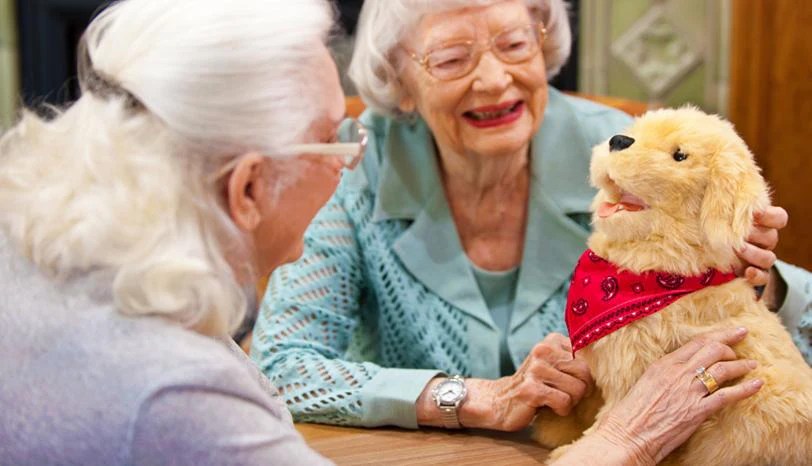Robot Pets: Fighting Loneliness One Purr at a Time

Imagine a cute, doe-eyed robotic seal pup bringing joy to an elderly person’s day. This is Paro, and it’s one of the best-known therapeutic robots. Over 30 years old, it was developed in Japan, a country leading the market in age tech robotics.
Japan introduced these robots to help support its aging population, now at 29% of citizens aged 65 and older. They’ve been quite successful. Meanwhile, robots are slowly gaining attention in the United States too. But why? Why are robotic pets becoming so essential for our older generation?
Rise of Therapeutic Robots
In the early 1990s, a researcher at Japan’s National Institute of Advanced Industrial Science and Technology began work on what would become Paro, a therapeutic robot. This doe-eyed seal pup remains one of the best-known examples of therapeutic robots for older adults, even after more than 30 years since its development. Japan leads the age tech robotics market due to its aging population, with 29% of its citizens aged 65 and older.
Japan’s increasing life expectancy, although beneficial, also results in an erosion of the support structure for the elderly. Robots have long been considered a means to address care shortages and alleviate loneliness among older adults. This approach has been widely adopted in Japan, but less so in the United States. However, with an aging population, the U.S. is beginning to explore similar technologies.
New York’s Initiative
For several years, New York state’s Office for the Aging (NYSOFA) has been working to introduce robotic pets to older adults. Since 2018, the department has distributed over 31,500 robot pets to older New Yorkers. Acting Director Greg Olsen was inspired by his daughter, who purchased a robotic pet from Amazon. Seeing its potential, Olsen thought, ‘This would be amazing to try.’
NYSOFA offers three types of robotic pets: a retriever-like dog, a cat, and red and blue birds. These pets are produced by Ageless Innovations, a company founded in 2015 as a Hasbro spinoff. The cat was the first to launch, followed by the dog in 2016, and the ‘Walker Squawker’ bird, which assists people using walking devices. The retriever dog is currently the most popular choice.
The Loneliness Epidemic
In the same year the NYSOFA started its pilot program, U.S. Surgeon General Vivek Murthy identified loneliness as critically detrimental to health. According to Murthy, loneliness impacts life expectancy similarly to smoking 15 cigarettes a day and is even more harmful than obesity. Isolation also speeds up cognitive decline in older individuals.
The situation worsened during the COVID-19 pandemic, leading Murthy to label loneliness as an epidemic. Studies show that pet ownership effectively fights loneliness, but many older adults cannot care for real pets due to various reasons. That’s where robotic pets come into play, offering companionship without the demands of real animals.
Impact of Robotic Pets
Research on robotic pets is still emerging, but early findings suggest they can help reduce depression and loneliness. A 2022 study found that companion robots provided meaningful activity and positive experiences, particularly during severe COVID-19 restrictions when human interaction was minimal.
Notably, the study highlighted that human interaction remains crucial. Conversations between participants, their families, and caregivers significantly improved the therapeutic environment.
Acting Director Olsen shares numerous success stories, such as a woman who proclaimed that they’d have to ‘pry this cat from my dead hands’ and another individual who wished to be buried with his robot pet. These anecdotes underline the deep attachments formed between older adults and their robotic companions.
Broader Technological Partnerships
While robotic pets have demonstrated promise in alleviating loneliness, they are not a standalone solution. The NYSOFA has established multiple partnerships with tech companies to support older adults. One notable partnership is with Intuition Robotics, creators of ElliQ, a social robot that helps users stay connected with loved ones and monitors their well-being.
The NYSOFA also offers services such as transportation and phone trees to support older adults. The robotic pet program is just one among many initiatives aimed at improving the quality of life for the elderly.
Personal Touch
The success of these programs often comes down to personal stories. Olsen recounts numerous instances where robotic pets have profoundly impacted lives, bringing joy and companionship to those who have felt isolated.
These stories highlight the human aspect of the technological initiative, showing that while robots offer companionship, the real value comes from the joy and comfort they bring to people’s lives.
In conclusion, robotic pets serve as a valuable tool in combating loneliness and improving the lives of older adults. However, they are most effective when used in conjunction with human interaction and other supportive services.
Future Outlook
The future looks promising for the use of therapeutic robots. Continued research and development are likely to yield even more sophisticated and effective robotic companions. As society grapples with an aging population, these innovations will play a crucial role in ensuring that older adults live fulfilled and connected lives.
With technology rapidly evolving, it’s exciting to imagine what the next generation of therapeutic robots might bring. From advanced AI capabilities to more lifelike designs, the possibilities are endless.
Therapeutic robots like Paro and robotic pets from NYSOFA’s initiative offer promising solutions to senior loneliness. Research shows these robots can reduce depression and provide meaningful companionship. However, they work best with human interaction and other support services. Future advancements in this field are likely to bring even more innovative solutions, ensuring older adults lead happier, more connected lives.





